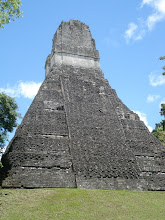5/26/10
Tabu in Latin America
Food and culture
3/29/10
Jonna's Visit
My identity
My feelings as a L1 speaker
I feel pretty much comfortable with traditions, beliefs, costums, behaviors and some other aspects of Costa Rican culture, because I had grown in this culture. However, my knowledge is basically from the places where I have lived, like San José and Alajuela.
During my childhood I lived in San José. In 1990, at the age of eleven, my family moved to Alajuela. In this move, I experienced culture shock. Eventhough, Alajuela and San José are part of the same country, their inhabitants beliefs, costums and traditions are different. Also, many expressions and vocabulary is quite different.
For example, one day, in the new school, I asked a classmate to borrow me her pencil sharpener (I called it “tajador”) and she didn’t understand me. Inmediately, she asked, “what do you need?” I answered her, “I need something to sharpen my pencil” and she said, “Ah, you’re asking for a “maquinilla.” “Yes, that’s what I need,” I said. What I mentioned before, is just an example of a bunch of experiences I had with culture shock, although my family and I moved to a different province in the same country.
My feelings as a L2 speaker
I have never lived in an English speaking country but I have traveled to USA twice. During my trip I could observe many culture behaviors such as,
- ü Hot chocolate milk preparation
- ü Extreme security in most places
- ü Fast food prevails everywhere
- ü Coffee drinkers
- ü Well cleanup streets
These were things that I didn’t learn when studying English. I learned them when I was inmersed in that country for a couple of weeks. Now, I have to research for many other things about this culture to be able to transmite these data to my classmates. I still have to learn more things about USA.
Acculturation
It is a stage that comes after a culture shock. It is the process of becoming used to or even adopting traditions, beliefs, values, behaviors of a surrounding culture.
Teachers of a second language should be aware of that the language they are teaching have a particular culture. So, it is important to consider this idea during the learning process. Foreign language learners must know customs, traditions, beliefs, body language (non verbal communication), typical food, manners, and many other things about the target language.
Probably, some of these language learners could travel to the target language country and all this prior knowledge could help them minimize their culture shock and overcome the process of acculturation. Therefore, teachers must not forget to include culture aspects in their teaching process.
Bizarre things and beliefs
In the other hand, it is commonly heard that dogs are the best friends of humans. However for Muslims, dogs are only considered guard or working animals. They don´t keep them as pets. This is the first time, I hear that a particular group of people don´t have dogs as pets.
Learning about cultures
It was really interesting to hear from them particular aspects of their culture, such as living style, socioeconomic activities, education, traditions, costums among others. I didn´t know many things about German people, besides what I studied realted to World War I and World War II. After this particular encounter, I could eliminate many thoughts and beliefs I had from these people.
Another way, how we can learn about other cultures is by cooking. So that a look to this site. I haven't thought of this before.
3/8/10
The Wonders of the Culture
Uganda
In Ankole culture, the aunt’s gift to her nephew’ bride was to teach her everything she knew about pleasing a man in all aspects including bed skills. The lessons will go as far as the aunt showing the bride practically on the wedding night by sharing the groom’s bed.
The best gift that the father gave to his son on the wedding night was to help him perform his manly duties on the wedding night. This meant for the father-in-law to sleep with the bride before the groom.
As late as the 1980s, women in some rural areas had to kneel when speaking to a man.
Taken from http://www.bukisa.com/articles/125596_bizarre-customs-and-traditions-from-around-the-world
2/27/10
Video: Children see. Children do.
2/25/10
Didactic Unit/Proposal
Topics:
Cultural Event: Afro-Costa Rican’s Day
ü Afro Costa Rican’s Customs
ü Afro Costa Rican’s Food
ü Afro Costa Rican’s Language
ü Afro Costa Rican’s Music
Objectives
ü Understand and respect socio-cultural aspects of Afro Costa Rican’s who lived in Limón.
- Recognize folktales of the Afro Costa Rican’s culture.
- Dramatize Afro Costa Rican’s folktales.
- Recognize typical food from Limón.
- Prepare typical food from Limón.
- Recognize the differences between Criole English and English pronunciation.
- Listen to Calypso music.
- Follow Calypso’s rythmn with body movements.
Contents
1. Folktales
2. Typical food
3. Criole English
4. Calypso
Context
This “Unidad Didáctica” is adressed to a group of students of a private elementary school in Santa Ana. One of the school’s purposes is to encourage children to respect their country’s cultural aspects by celebrating events as Afro Costa Ricans Day, among others.
Audience
This “Unidad Didáctica” is adressed to first graders between 7 and 8 years old.
Resources
The following resources will be used as background:
ü Websites
ü Books
ü Afro Caribbean Authors/Professors: Quince Duncan, Eulalia Bernard
ü Linguistics Final Projects
ü Afro Caribbean Music: Calypso
These resources will be created by the teacher:
ü Coloring pages
ü Texts
ü Crossword
ü Word search
ü Questionnaires
